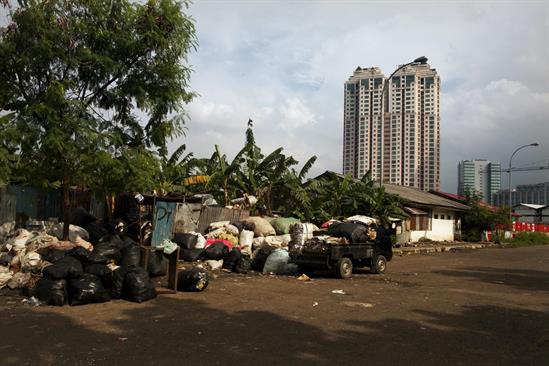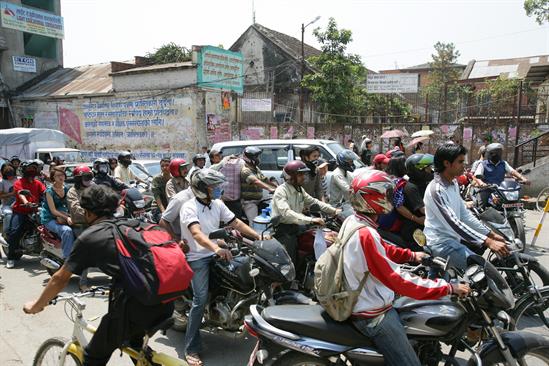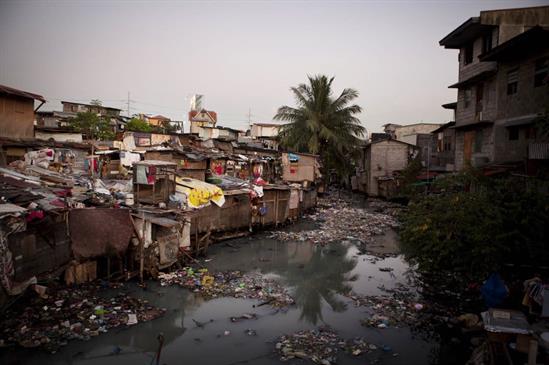Health risks
Urban green spaces

Dense housing settlements due to urbanization in Nepal
Green spaces such as parks and sports fields as well as woods and natural meadows, wetlands or other ecosystems, represent a fundamental component of any urban ecosystem. Green urban areas facilitate physical activity and relaxation, and form a refuge from noise. Trees produce oxygen, and help filter out harmful air pollution, including airborne particulate matter. Water spots, from lakes to rivers and fountains, moderate temperatures.
Urban parks and gardens play a critical role in cooling cities, and also provide safe routes for walking and cycling for transport purposes as well as sites for physical activity, social interaction and for recreation. Recent estimates show that physical inactivity, linked to poor walkability and lack of access to recreational areas, accounts for 3.3% of global deaths.
Green spaces also are important to mental health. Having access to green spaces can reduce health inequalities, improve well-being, and aid in treatment of mental illness. Some analysis suggests that physical activity in a natural environment can help remedy mild depression and reduce physiological stress indicators.
Climate risks

Large paved expanses can exacerbate the urban heat island effect, as shown here in Indonesia
Cities both impact climate change and are impacted by climate change – in a cycle that also generates multiple health effects, as described briefly here.
Cities’ impacts on climate
Cities, especially those in high-income areas, are significant contributors to climate change insofar as they represent some 67-76% of global energy use according to the Intergovernmental Panel on Climate Change (IPCC, 2014/Chapter 12). Urban climate emissions include not only CO2, a long-lived pollutant that persists hundreds of years in the atmosphere, but also short-lived climate pollutants, particularly black carbon and methane.
CO2 emissions
Urban energy consumption accounts for about three quarters of global CO2 emissions. Carbon dioxide persists in the atmosphere for centuries, with long-term warming effects (IPCC, 2014).
Inefficient urban land use, housing and building design, inefficient transport systems, and reliance upon fossil fuels, particularly coal, for power, are key urban factors driving CO2 emissions.
Short-lived climate pollutants (SLCPs)
Urban emissions also contain significant short-lived climate pollutants. These include:
- Black carbon, a component of particulate matter, emitted primarily by diesel vehicles, fuel and diesel building heating systems, diesel power generators and biomass combustion. On a twenty year horizon, black carbon has a global warming potential 3200 times greater than CO2 – although it only persists in the atmosphere for a few days to a week. Black carbon is a key component of particulate matter, the air pollutant most closely associated with air pollution-related premature mortality. In low-income cities, coal and biomass cookstove combustion are significant contributors to black carbon emissions, insofar as an estimated one-quarter of urban residents rely upon solid fuel stoves.
- Methane is a gas produced by the biodegradation of sewage and solid waste, as well as during the combustion of coal. Its global warming potential is 84 times more powerful than CO2, although it only persists in the atmosphere for about a decade. So measures to reduce methane and black carbon can also have a more immediate “cooling” effect -- slowing the pace of climate change.
- Ozone develops from the intermingling of urban pollutants including nitrogen oxides (NOx), carbon monoxide (CO), methane and other hydrocarbons. In of itself, ozone may also be considered a short-lived climate pollutant – which causes significant respiratory illness and reduced crop productivity.
Climate change impacts on cities
Cities also are among the areas most vulnerable to climate change in the following ways:
- Sea level rise threatens major coastal cities with increased flooding, and increased storm and rainfall intensity will exacerbate impacts. Major cities on a coastline include Buenos Aires, Argentina; Tokyo, Japan; Cairo, Egypt; Shanghai, China; and New York City, United States.
- The “urban heat island” effect is unique to cities, and will become even more pronounced as climate-change related heat waves become more frequent. The effect is most pronounced in cities characterized by large expanses of urban paved and concrete structures, which absorb radiant heat, and conversely, a lack of reflective or green spaces to effect cooling. The heat island effect can raise average center city temperatures anywhere from 3-5⁰ C above those in the surrounding countryside. The heat island effect also makes city power grids more vulnerable to extreme-weather events.As power demands for air conditioning rise sharply during heat waves, this creates a vicious cycle of more climate change emissions.
- The urban poor are the worst affected by climate change. Slum dwellers’ homes tend to be poorly constructed and thus the most exposed to extremes of temperature and weather. Slum neighbourhoods are likely to be sited in vulnerable locations, along beaches or on slopes prone to landslides. Water, sewage, road and electricity systems are likely to be less resilient to extreme weather events.
Air pollution

Motorcyclists in Nepal wear masks to protect themselves from heavy traffic fumes
Some 3.8 million premature deaths annually are attributed to outdoor (ambient) air pollution. About 80% of those deaths are due to heart disease and stroke, while another 20% are from respiratory illnesses and cancers related to exposure to fine particulate matter (PM2.5), the most health-harmful air pollutant.
According to WHO’s most recent survey of 4300+ cities worldwide, only 20% of the urban population surveyed live in areas that comply with WHO air quality guideline levels for PM2.5. Average particulate air pollution levels in many developing cities can be 4-15 times higher than WHO air quality guideline levels, putting many at risk of long-term health problems.
Ground-level ozone, produced by the atmospheric interaction of a mix of air pollutants, including methane and NOx, is another health risk, raising rates of asthma and chronic respiratory illness as well as other sorts of breathing problems and reduced lung function. Ozone also reduces crop productivity in peri-urban areas, where ozone levels may often be heaviest.
In most low and middle-income cities where historical comparisons are possible, air pollution has become worse over the past several years. Many factors contribute to this increase, including increased urban power demand, which drives up power plant emissions, and soaring use of private motor vehicle transport.
Building heating and cooling systems, often energy inefficient, also play a role as do industrial emissions, when industries are located in close proximity to cities and homes. In low income and some middle-income cities, the incineration of solid waste, burning of agricultural waste in periurban areas, and the use of solid fuels (coal and biomass) for cooking and heating are also serious urban air pollution issues.
Some 25% of households in less-developed cities are reliant on solid fuels for cooking. Those households face a double air pollution burden – polluted air outdoors as well as the polluted air inside the home.
Housing-related health risks

A slum area in Manila, Philippines
Poorly planned or unplanned urbanization patterns represent a major public health challenge. This most vividly represented by the persistence of urban slums, which are home to an estimated 828 million people, one third of the world’s urban population. From 2000 to 2012 the global proportion of people living in slums decreased from 39% to 33% of the urban population, however, the absolute number of slum dwellers grew over this period from 700 million in 2000 to 863 million in 2012.
UN-HABITAT defines a slum as lacking at least one of the following: a) access to safe water, b) access to sanitation, c) safe and secure tenure, or d) durable housing structures. “Durable” housing mean housing that is located away from natural or manmade hazards; is structurally safe, and protective against extreme weather. Crowding and economic deprivation further exacerbates the housing and health risks of slum dwellers.
Overcrowded, substandard housing facilitates the spread of infectious diseases, such as tuberculosis, hepatitis, dengue fever, pneumonia, cholera and malaria. Poor sanitation and lack of access to safe food and water contribute to high prevalence of diarrhoea within slums. The lack of structurally sound, climate-adapted and ventilated homes further puts the health of slum dwellers at risk of climate change-related extreme weather – including heat waves, cold or storms.
Moreover, slum areas are often left out of major city networks for access to health-care services. Unplanned urban development exacerbates non-communicable disease risks related to outdoor and indoor air pollution. Furthermore, urban sprawl is associated with road traffic injury and physical inactivity-related risks including obesity.
Nutrition insecurity and unhealthy diets

Urban food security in developing countries is close tied to food price fluctuations. In poor cities, increases in food prices can rapidly translate into hunger and malnutrition among the urban poor. Urban households with lower socioeconomic status tend to spend more than 70% of their income on food, impacting the availability of funds for education, child care and other activities.
At the same time, rapid urbanization has been associated with an increase in energy-dense diets, characterized by high levels of refined sugars, salt, and other additives, increased saturated fat intake (mainly from animal source foods), and reduced intakes of complex carbohydrates, fibre, fruits, and vegetables. Frequently, diet changes are linked to increased meat and dairy consumption in low and middle-income cities, as urbanization is a driver of global demand for animal products.
These changing dietary patterns have been referred to as the “nutrition transition”. In cities around the world, obesity and overweight, cancers, diabetes, cardiovascular diseases associated with high sugar and saturated fat consumption (among higher income consumers) are on the rise.
Outside of the least developed countries, it is the urban poor that are at highest risk of obesity, due to the fact that the cheapest and most accessible foods are likely to be calorie-dense, fast- and processed foods. Among higher-income groups in developing cities, overconsumption of saturated fats and red meat, often also in the form of fast foods, is also a looming health issue, as per developed city counterparts.
A shift to consumption of added sugars is also particularly marked among low-income countries, while in affluent regions of North America and Europe, saturated fat intake is above the WHO recommended 10% of total energy intake. Increases in Type 2 diabetes incidence generally correlate with shifts to energy-dense diets and/or to diets high in saturated fats. Dietary factors also account for 30% of cancers in developed countries and 20% in developing countries- a figure which appears to also be increasing along with dietary transitions. The health impacts of dietary transition are compounded by increasingly sedentary lifestyles.
Meanwhile, high income cities also face nutrition challenges. Consumption of calorie-dense foods, sugary soft drinks and processed foods is often higher in poor neighbourhoods. In such neighbourhoods, depressed economic conditions often have led to the closure of traditional corner grocers, while larger supermarkets have migrated to the suburbs, creating a dearth of fresh food markets. The consequent dearth of nutritious food outlets makes healthier diets far more expensive; such urban areas have been described as “food deserts.”
Unsafe drinking-water, sanitation and waste management

Diseases due to poor drinking-water access, unimproved sanitation, and poor hygiene practices cause 4.0% of all deaths and 5.7% of all disability or ill health in the world. About 80% of urban dwellers have access to piped drinking water and 96% have access to improved drinking water sources. However, often the bacteriological quality of this water remains poor; more than 50% of urban residents in developing countries are still affected at one time or another by diseases related to insufficient access to safe drinking-water and improved sanitation.
Contaminated drinking-water is estimated to cause more than 500 000 diarrhoeal deaths each year. Contaminated water can transmit diseases such as diarrhoea, cholera, dysentery, typhoid and polio. Health costs associated with waterborne diseases such as malaria, diarrhoea, and worm infections represent more than one third of the income of poor households in sub-Saharan Africa.
Health risks are often exacerbated by poor sanitation. Some 20% of the urban population still lacked access to improved sanitation in 2012 and 100 million city dwellers still practiced open defecation – although gains in access to improved sanitation have generally been much more rapid in cities than in rural areas over the past two decades.
Urban solid waste disposal is another sanitation-related challenge. Recent estimates also suggest that cities generate 1.3 billion tonnes of solid waste per year, a figure expected to rise to 2.2 billion tonnes by 2025. Failure to adequately collect and dispose of solid waste presents can increase the proliferation of disease-carrying vectors, such as rodents and insects. These risks can be exacerbated by other urban conditions, such as overcrowding.
Social inequities in cities play an important role in water and sanitation-related risks – with informal settlements and slums generally having lower levels of access than other parts of the city. Due to crowding and other factors, slums can thus become a nexus for water and sanitation-related infectious disease transmission.
Slums and other dense, informal urban neighbourhoods pose challenges for improving sanitation provision insofar as sewer systems will likely be required, but also costly to install within established and densely-populated neighbourhoods. Urban sprawl also makes sewage infrastructure more costly to install and energy intensive to operate – as compared to planned, compact development where infrastructure is built in advance and gravity flow can be used to pump sewage downhill. Some studies (e.g. in South Africa) tested safe, low-cost, on-site biological sewage treatment in urban residential settings.
